UPDATED
China moon probe Chang'e-5 lands back on Earth
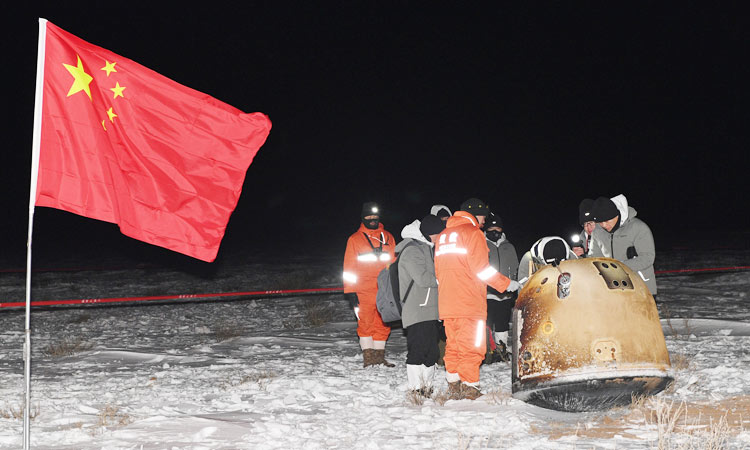
Researchers work around Chang'e-5 carrying moon samples next to a Chinese national flag in Siziwang. Reuters
Gulf Today Report
China's Chang'e-5 moon probe has landed in the northern Chinese region of Inner Mongolia, with the first fresh samples of rock and debris from the moon in more than 40 years.
The official Xinhua news agency reported that the capsule of the Chang’e 5 probe landed just before 2am (1800 GMT Wednesday) in the Siziwang district of the Inner Mongolia region.
The state media also said the capsule earlier separated from its orbiter module and performed a bounce off Earth’s atmosphere to reduce its speed before passing through and floating to the ground on parachutes.
Two of the Chang’e 5’s four modules set down on the moon on Dec.1 and collected about 2 kilogrammes (4.4 pounds) of samples by scooping them from the surface and drilling 2 metres (about 6 feet) into the moon’s crust. The samples were deposited in a sealed container that was carried back to the return module by an ascent vehicle.
Recovery crew members film the capsule of the Chang'e 5 probe after it successfully landed in Siziwang district. AP
The successful mission was the latest breakthrough for China’s increasingly ambitious space programme that includes a robotic mission to Mars and plans for a permanent orbiting space station.
Chinese leader Xi Jinping, in a statement read out at the Beijing Aerospace Control Center, called it a major achievement that marked a great step forward for China's space industry, state-run Xinhua News Agency said.
He expressed hope that mission participants would continue to contribute toward building China into a major space power and national rejuvenation, the agency reported.
Recovery crews had prepared helicopters and off-road vehicles to home in on signals emitted by the lunar spacecraft and locate it in the darkness shrouding the vast snow-covered region in China's far north, long used as a landing site for China’s Shenzhou crewed spaceships.
Recovery crew members check on the capsule of the Chang'e 5 probe after its successful landing in Siziwang district. AP
The spacecraft’s return marked the first time scientists have obtained fresh samples of lunar rocks since the former Soviet Union’s Luna 24 robot probe in 1976.
The newly collected rocks are thought to be billions of years younger than those obtained earlier by the US and former Soviet Union, offering new insights into the history of the moon and other bodies in the solar system. They come from a part of the moon known as the Oceanus Procellarum, or Ocean of Storms, near a site called the Mons Rumker that was believed to have been volcanic in ancient times.
As with the 382 kilograms (842 pounds) of lunar samples brought back by US astronauts from 1969 to 1972, they will be analyzed for age and composition and are expected to be shared with other countries.
The age of the samples will help fill in a gap in knowledge about the history of the moon between roughly 1 billion and three billion years ago, Brad Jolliff, director of the McDonnell Center for the Space Sciences at Washington University in the US city of St. Louis, wrote in an email. They may also yield clues as to the availability of economically useful resources on the moon such as concentrated hydrogen and oxygen, Jolliff said.
A researcher works next to Chang'e-5 lunar return capsule carrying moon samples in Siziwang district. Reuters
“These samples will be a treasure trove!” Jolliff wrote. “My hat is off to our Chinese colleagues for pulling off a very difficult mission; the science that will flow from analysis of the returned samples will be a legacy that will last for many, many years, and hopefully will involve the international community of scientists.”
Chang’e 5 blasted off from a launch base in China’s southern island province of Hainan on Nov. 23 and appeared to have completed its highly technically sophisticated mission without a hitch.
It marked China’s third successful lunar landing but the only one to lift off again from the moon. Its predecessor, Chang’e 4, became the first probe to land on the moon’s little-explored far side and continues to send back data on conditions that could affect a future extended stay by humans on the moon.
A Chinese Probe Just Brought Back The First New Samples From The Moon in Decades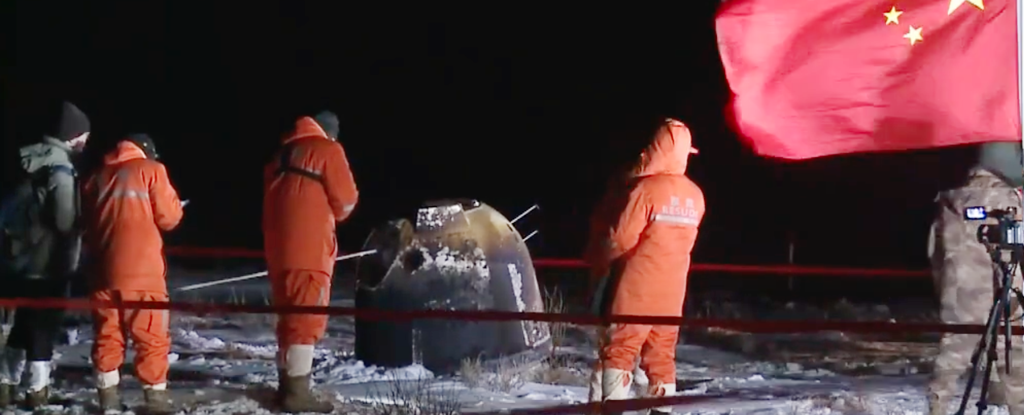
(New China TV/YouTube)
SPACE
AFP
16 DECEMBER 2020
An unmanned Chinese spacecraft carrying rocks and soil from the Moon returned safely to Earth early Thursday in the first mission in four decades to collect lunar samples, the Xinhua news agency said.
The return module of the space probe known as Chang'e-5 landed in northern China's Inner Mongolia region, Xinhua said, quoting the China National Space Administration.
Beijing is looking to catch up with the US and Russia after taking decades to match its rivals' achievements and has poured billions into its military-run space programme.
The spacecraft, named after a mythical Chinese Moon goddess, landed on the Moon on December 1 and began its return voyage two days later. While on the Moon it raised the Chinese flag, China's space agency has said.
Scientists hope the samples will help them learn about the Moon's origins, formation and volcanic activity on its surface.
With this mission, China became only the third country to have retrieved samples from the Moon, following the United States and the Soviet Union in the 1960s and 1970s.
This was the first such attempt since the Soviet Union's Luna 24 mission in 1976.
The spacecraft's mission was to collect two kilograms (4.5 pounds) of material in an area known as Oceanus Procellarum – or "Ocean of Storms" – a vast, previously unexplored lava plain, according to the science journal Nature.
Under President Xi Jinping, plans for China's "space dream", as he calls it, have been put into overdrive.
China hopes to have a crewed space station by 2022 and eventually send humans to the Moon.
© Agence France-Presse
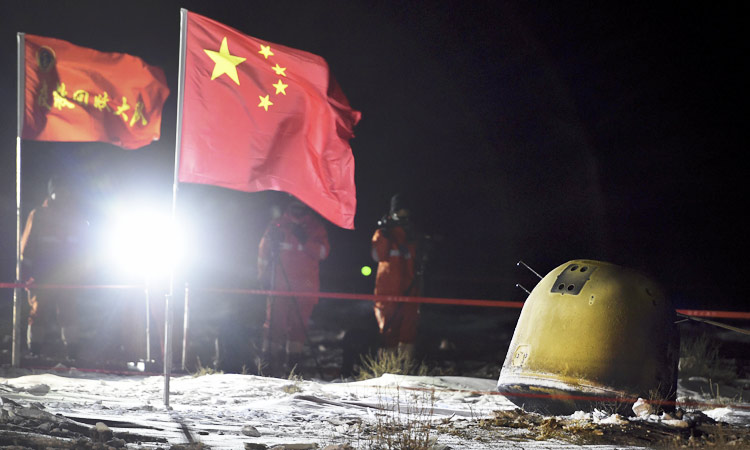
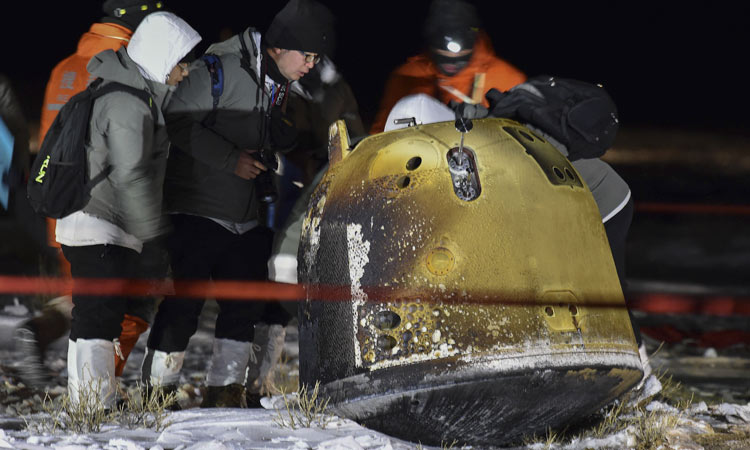
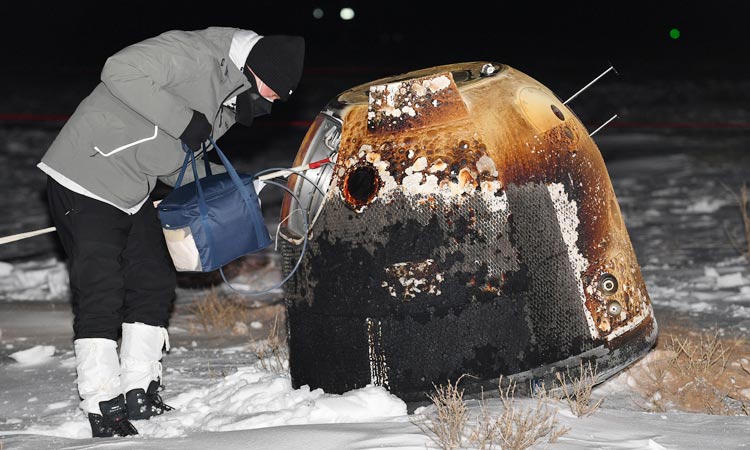
No comments:
Post a Comment